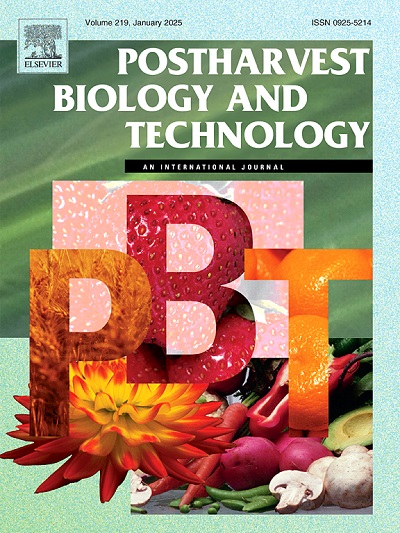静电纺丝法制备meja负载PVA/CCNFs纳米纤维膜用于蓝莓保鲜:开发、表征及应用
IF 6.4
1区 农林科学
Q1 AGRONOMY
引用次数: 0
摘要
以聚乙烯醇(PVA)、羧化纤维素纳米纤维(CCNFs)和茉莉酸甲酯(MeJA)为原料,采用静电纺丝技术制备了一种新型纳米纤维薄膜,以延长蓝莓的保质期。结果表明,含8 wt%和10 wt% MeJA的膜具有显著的抗菌活性;然而,当浓度超过8 wt%时,薄膜的机械强度和水蒸气阻隔性能就会降低。因此,选择8 wt% MeJA/CCNFs/PVA薄膜进行进一步的微观结构表征和蓝莓保存研究。MeJA的加入使平均纤维直径减小到128.1 nm,保证了组分分布均匀。纳米纤维薄膜具有良好的生物降解性,在自然条件下可在3 h内完全降解。8 wt% MeJA/CCNFs/PVA膜具有缓释能力,能有效减少蓝莓采后的腐烂和失重,延缓软化,最大限度地减少营养物质的降解,从而延长蓝莓的保质期。这些发现凸显了meja负载PVA/CCNFs纳米纤维薄膜作为一种创新和可持续的采后保存解决方案的潜力。本文章由计算机程序翻译,如有差异,请以英文原文为准。
Preparation of MeJA-loaded PVA/CCNFs nanofiber film via electrospinning for blueberry preservation: Development, characterization, and application
A novel nanofiber film to extend the shelf life of blueberries was developed via electrospinning by combining polyvinyl alcohol (PVA), carboxylated cellulose nanofibers (CCNFs), and methyl jasmonate (MeJA). The results show that films with 8 wt% and 10 wt% MeJA exhibited significant antimicrobial activity; however, concentrations exceeding 8 wt% compromised the mechanical strength and water vapor barrier performance of the films. Consequently, the 8 wt% MeJA/CCNFs/PVA film was selected for further microstructural characterization and blueberry preservation studies. The incorporation of MeJA reduced the average fiber diameter to 128.1 nm and ensured homogeneous component distribution. The nanofiber films exhibited excellent biodegradability and were completely degraded within 3 h under natural conditions. Because of its sustained-release capability, the 8 wt% MeJA/CCNFs/PVA film effectively reduced postharvest decay and weight loss, delayed softening, and minimized nutrient degradation, thereby extending the shelf life of blueberries. These findings highlight the potential of MeJA-loaded PVA/CCNFs nanofiber films as an innovative and sustainable solution for postharvest preservation.
求助全文
通过发布文献求助,成功后即可免费获取论文全文。
去求助
来源期刊

Postharvest Biology and Technology
农林科学-农艺学
CiteScore
12.00
自引率
11.40%
发文量
309
审稿时长
38 days
期刊介绍:
The journal is devoted exclusively to the publication of original papers, review articles and frontiers articles on biological and technological postharvest research. This includes the areas of postharvest storage, treatments and underpinning mechanisms, quality evaluation, packaging, handling and distribution of fresh horticultural crops including fruit, vegetables, flowers and nuts, but excluding grains, seeds and forages.
Papers reporting novel insights from fundamental and interdisciplinary research will be particularly encouraged. These disciplines include systems biology, bioinformatics, entomology, plant physiology, plant pathology, (bio)chemistry, engineering, modelling, and technologies for nondestructive testing.
Manuscripts on fresh food crops that will be further processed after postharvest storage, or on food processes beyond refrigeration, packaging and minimal processing will not be considered.
 求助内容:
求助内容: 应助结果提醒方式:
应助结果提醒方式:


